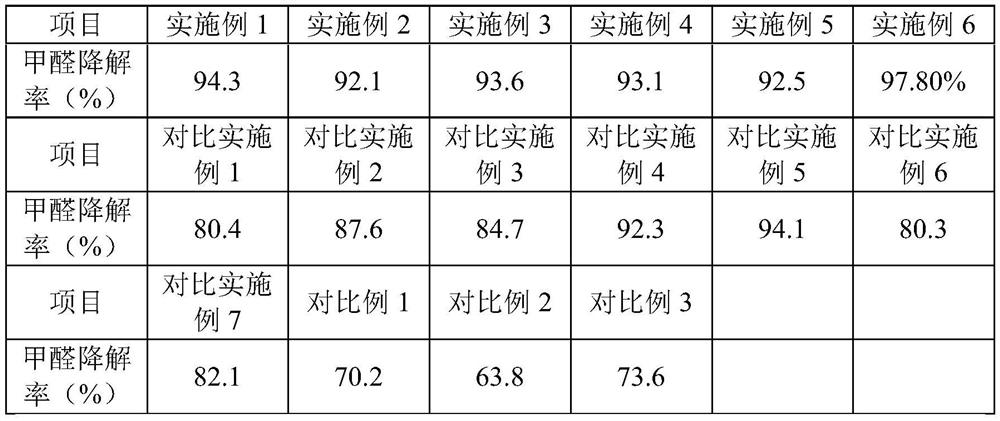Method for efficiently degrading indoor formaldehyde
A formaldehyde and high-efficiency technology, applied in the field of high-efficiency degradation of indoor formaldehyde, can solve problems such as low efficiency
- Summary
- Abstract
- Description
- Claims
- Application Information
AI Technical Summary
Problems solved by technology
Method used
Image
Examples
Embodiment 1
[0045] This embodiment provides a method for efficiently degrading indoor formaldehyde, comprising the following steps:
[0046] S1, configure solid medium A, its formula is: beef extract 3g / L, peptone 10g / L, sodium chloride 5g / L, potassium dihydrogen phosphate 0.6g / L, dipotassium hydrogen phosphate 0.85g / L, agar 20g / L, and trace element solution 550μL / L. The trace element solution is prepared by dissolving the following raw materials in deionized water: boric acid 6g / L, copper chloride 0.2g / L, cobalt chloride 4g / L, nickel chloride 0.4g / L, zinc sulfate 2g / L, chlorine Manganese chloride 0.6g / L.
[0047] Configure solid LB medium, its formula is: tryptone 10g / L, yeast extract 5g / L, sodium chloride 10g / L, agar 20g / L.
[0048] Configure solid medium B, its formula is: sodium malate 1.0g / L, sodium acetate 1.0g / L, ammonium chloride 1.0g / L, potassium dihydrogen phosphate 1.0g / L, calcium chloride 0.1g / L, Sodium bicarbonate 2.9g / L, magnesium chloride 0.4g / L, trace element solution ...
Embodiment 2
[0058] The difference between this embodiment and Embodiment 1 is that some process parameters are different in the method of this embodiment, specifically: a method for efficiently degrading indoor formaldehyde, comprising the following steps:
[0059] S1. Configure solid medium A, its formula is: beef extract 2.5g / L, peptone 9g / L, sodium chloride 4g / L, potassium dihydrogen phosphate 0.5g / L, dipotassium hydrogen phosphate 0.7g / L, agar 18g / L, and trace element solution 500μL / L. The trace element solution is prepared by dissolving the following raw materials in deionized water: boric acid 5g / L, copper chloride 0.1g / L, cobalt chloride 3g / L, nickel chloride 0.3g / L, zinc sulfate 1.5g / L, Manganese chloride 0.4g / L.
[0060] Configure solid LB culture medium, its formula is the same as embodiment 1.
[0061] Configure solid medium B, its formula is: sodium malate 0.8g / L, sodium acetate 0.8g / L, ammonium chloride 0.8g / L, potassium dihydrogen phosphate 0.8g / L, calcium chloride 0.08g / L...
Embodiment 3
[0071] The difference between this embodiment and Embodiment 1 is that some process parameters are different in the method of this embodiment, specifically: a method for efficiently degrading indoor formaldehyde, comprising the following steps:
[0072] S1, configure solid medium A, its formula is: beef extract 3.5g / L, peptone 12g / L, sodium chloride 6.5g / L, potassium dihydrogen phosphate 0.7g / L, dipotassium hydrogen phosphate 0.85g / L, Agar 22g / L, and trace element solution 600μL / L. The trace element solution is prepared by dissolving the following raw materials in deionized water: boric acid 7g / L, copper chloride 0.3g / L, cobalt chloride 5g / L, nickel chloride 0.5g / L, zinc sulfate 2.5g / L, Manganese chloride 0.8g / L.
[0073] Configure solid LB culture medium, its formula is the same as embodiment 1.
[0074] Configure solid medium B, its formula is: sodium malate 1.3g / L, sodium acetate 1.3g / L, ammonium chloride 1.3g / L, potassium dihydrogen phosphate 1.3g / L, calcium chloride 0.13g...
PUM
 Login to View More
Login to View More Abstract
Description
Claims
Application Information
 Login to View More
Login to View More - R&D
- Intellectual Property
- Life Sciences
- Materials
- Tech Scout
- Unparalleled Data Quality
- Higher Quality Content
- 60% Fewer Hallucinations
Browse by: Latest US Patents, China's latest patents, Technical Efficacy Thesaurus, Application Domain, Technology Topic, Popular Technical Reports.
© 2025 PatSnap. All rights reserved.Legal|Privacy policy|Modern Slavery Act Transparency Statement|Sitemap|About US| Contact US: help@patsnap.com

